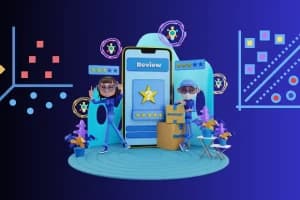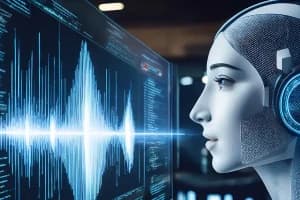Voice assistants are no longer just simple voice-command devices; they have evolved into intelligent beings that will change how we live, work, and interact with technology. In 2025, these NextGen AI voice assistants will respond to commands and learn, predict, and personalize user experiences like never before.
What are NextGen AI Voice Assistants?
NextGen AI voice assistants represent a significant leap in technology. Imagine this: you're rushing out the door, and your assistant not only reminds you of your keys but also checks traffic updates, orders your coffee for pickup, and suggests a podcast to listen to based on your mood. This level of contextual understanding, emotional intelligence, and proactive assistance defines the essence of these advanced systems.
By combining state-of-the-art natural language processing (NLP), machine learning (ML), and voice cloning technologies, NextGen AI voice assistants become more than just tools-they become companions, seamlessly integrating into daily routines and enriching lives through hyper-personalized interactions.
How Do NextGen AI Voice Assistants Work?
These innovative systems rely on several deep-seated technologies that are intertwined and must be seamlessly integrated to provide rich contextual interfaces. Let's take a closer look:
- Speech-to-Text Conversion (ASR): Just think saying to your assistant, "Please set up a meeting at 2 PM with Sarah." Automatic Speech Recognition (ASR) intervenes and converts the user's words into digital text as soon as the words are spoken.
- Example: Google's ASR technology is accurate, specifically for this it can work even in the presence of noise.
- Natural Language Understanding (NLU): Once the text is generated, the understanding of the text's meaning takes place. NLU allows understanding of what exactly the assistant has to do - the intent "Schedule meeting" and the entities "2 PM" and "Sarah" should be mentioned for the correct completion of the task.
- Context Awareness: NextGen assistants pay special attention to time and place and also the user's preferences. For instance, if you're at work and say, 'Order lunch,' the assistant recognizes your favorite places to eat around the workplace and provides suggestions based on that.
- Emotional Intelligence: These assistants can understand your choice of words and your tone. When you say, 'Cancel my meetings,' the assistant might ask if you are too busy and move appointments around.
- Personalized Learning: It also learns about your habits, preferences, and even your routines, and renews its responses over time. For instance, it will know that you are more comfortable with tea than coffee in the morning or that you always call your preferred client on Mondays.
- Text-to-Speech (TTS): Lastly, the assistant transcribes its answers into a speech format making the experience natural and coherent.
Open-Source Examples of AI Voice Assistants
For those eager to explore this field, open-source projects offer an excellent starting point:
- Mycroft AI: This Helper can be controlled on PCs, Raspberry Pi, or any other device. In my experience, the system is largely customizable because it has a very engaged developer community.
- GitHub: Mycroft AI
- Rhasspy: An offline-first assistant which is perfect for rather private users. It is easily customizable to suit diverse uses because it is designed in a modular fashion.
- GitHub: Rhasspy
- DeepSpeech: Mozilla has created this speech recognition engine that is ideal for real-time transcription tasks.
- GitHub: DeepSpeech
Case Study: NextGen AI Voice Assistants in Healthcare
NextGen AI Voice Assistants bring forth the AI Revolution in Modern Healthcare with proactive, personalized, and Empathetic NLP, Machine Learning, contextual understanding, and depth.
1. Scheduling Appointments
For instance, when a working mother of two kids Sarah requires an appointment for her daughter Emma with a pediatrician, the assistant calls the healthcare provider's scheduling system, looks up the availability, - books an appointment of the preferred type and time - and sends an invitation with a reminder. This kills time for Sarah and also helps her to plan her time way better than the time that would be spent making the calls or searching for an online appointment.
2. Medication Reminders
The assistant also assists Sarah in her father's daily regime of heart medication by prompting her every evening reminding him or else alerting my father if connected to smart devices. This feature makes certain that no crucial medication is left unfilled, it helps in the administration of other chronic conditions too as it reminds the necessary medications at regular intervals, and last but not least, it helps Sarah by easing her mental burden and providing her with relief that her father's medical requirements are being met.
In real-world trials, such systems have shown potential to improve efficiency in hospitals, enabling staff to focus on patient care while administrative tasks are automated.
Projects on AI Voice Assistants on GitHub
Here are some detailed project ideas to inspire you:
-
AI Voice Assistant using Groq, Llama 3, and Deepgram
This project uses state-of-the-art artificial intelligence models to develop a real-time voice-based response system to answer queries. It uses Groq for processing, Llama 3 for language comprehension and Deepgram for speech-to-text conversion. A live demonstration shows what it can do for the users to benefit from.GitHub
-
Real-Time AI Voice Assistant with LLAMA 3 and ElevenLabs
This project enables natural, real-time conversations with an AI assistant using voice input. It employs AssemblyAI for speech-to-text conversion, LLAMA 3 for generating responses, and ElevenLabs for text-to-speech synthesis. The assistant listens to spoken questions, processes them, and provides spoken responses, facilitating seamless human-AI interaction. GitHub
-
Multi-ModalAI Voice AssistantThis project is a multi-modal AI voice assistant that uses OpenAI's GPT-4, audio processing with WhisperModel, speech recognition, clipboard extraction, and image processing to respond to user prompts.GitHub
-
Voice Cloning Application Using RVC
In this project, we create a Voice Cloning Application employing RVC (Retrieval-based Voice Conversion) and deep learning techniques. Details here
These projects showcase the advancements in AI voice assistant technology, offering insights into building sophisticated, real-time conversational agents.
NextGen AI Voice Assistants vs. Traditional Voice Assistants
| Feature | Traditional Voice Assistants | NextGen AI Voice Assistants |
| Language Understanding | Basic understanding, limited context awareness | Advanced NLP with deep contextual understanding |
| Conversation Flow | Single-turn interactions | Multi-turn, natural, and adaptive conversations |
| Personalization | Minimal personalization, mostly based on predefined settings | Highly personalized, learns user preferences over time |
| Emotional Intelligence | No understanding of tone or sentiment | Analyzes tone and sentiment to provide empathetic responses |
| Multi-modal Capabilities | Primarily voice-based interaction | Combines text, voice, images, and other input/output formats |
Build, Learn, and Excel in AI Voice Assistants
Imagine designing an assistant that becomes an integral part of someone's daily life. With platforms like our site, you can turn these ideas into reality. Explore curated projects, from beginner-level experiments to advanced systems, and gain the skills to excel in this exciting field.
FAQs on NextGen AI Voice Assistants
Q1: What programming languages are best for building AI voice assistants?
A1: Python, JavaScript, and C++ are commonly used for their flexibility and robust libraries.
Q2: Can I build a voice assistant without coding?
A2: Yes, platforms like Dialogflow and Alexa Skills Kit offer no-code options.
Q3: Are there privacy concerns with voice assistants?
A3: Yes, but using open-source and offline solutions like Rhasspy can address these issues.
Q4: What industries benefit most from voice assistants?
A4: Healthcare, education, retail, and smart homes are leading adopters.
The potential of AI voice assistants is limitless. Take the first step today and explore our website for curated projects that will elevate your skills and career.







